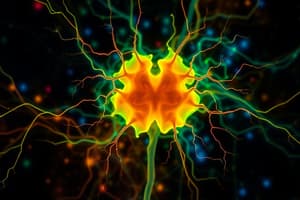Podcast
Questions and Answers
What method was used to ensure that the subjects understood the instructions before testing?
What method was used to ensure that the subjects understood the instructions before testing?
- They completed a verbal quiz about the instructions.
- They were given written instructions to read.
- They were presented with a simple dot display. (correct)
- They participated in a group discussion about the task.
How did control subjects generally group the dots in the display?
How did control subjects generally group the dots in the display?
- By random selection.
- On the basis of shape. (correct)
- By their proximity to one another.
- Based on the colors indicated.
What distinct grouping behavior was observed among the synaesthetes?
What distinct grouping behavior was observed among the synaesthetes?
- They grouped based on the colors induced. (correct)
- They grouped solely by size.
- They neglected color distinctions altogether.
- They were unable to group anything.
In the study, what was the main factor separating the grouping strategies of synaesthetes and control subjects?
In the study, what was the main factor separating the grouping strategies of synaesthetes and control subjects?
What characteristic of the dot display facilitated the grouping among subjects?
What characteristic of the dot display facilitated the grouping among subjects?
What visual organization is suggested when synaesthetes group objects by colour?
What visual organization is suggested when synaesthetes group objects by colour?
What did the subjects report about their experience of colours when viewing black and white photographs?
What did the subjects report about their experience of colours when viewing black and white photographs?
Which interpretation regarding synaesthesia is mentioned as being potentially compatible with each other?
Which interpretation regarding synaesthesia is mentioned as being potentially compatible with each other?
What type of subjects were used in the study to assess synaesthetic experiences?
What type of subjects were used in the study to assess synaesthetic experiences?
When looking at a banana, what did the subjects indicate about their perception of yellow?
When looking at a banana, what did the subjects indicate about their perception of yellow?
How many control subjects were tested for each synaesthete in the study?
How many control subjects were tested for each synaesthete in the study?
Which shape characteristic did normal control subjects use to organize the fruits and vegetables?
Which shape characteristic did normal control subjects use to organize the fruits and vegetables?
What must synaesthetically induced colours be able to do according to the study's hypothesis?
What must synaesthetically induced colours be able to do according to the study's hypothesis?
What phenomenon does the content suggest synaesthesia may arise from?
What phenomenon does the content suggest synaesthesia may arise from?
How were the graphemes presented to the synaesthetes in the study?
How were the graphemes presented to the synaesthetes in the study?
What was the main purpose of using functional magnetic resonance imaging methods in this study?
What was the main purpose of using functional magnetic resonance imaging methods in this study?
What did the observation of subject J.C. indicate regarding color experience and graphemes?
What did the observation of subject J.C. indicate regarding color experience and graphemes?
What reference is made to suggest an analogy for synaesthesia's mechanism?
What reference is made to suggest an analogy for synaesthesia's mechanism?
How many graphemes were used in the trials presented to the subjects?
How many graphemes were used in the trials presented to the subjects?
What key point is made about color memory in relation to grapheme visualization?
What key point is made about color memory in relation to grapheme visualization?
What was the mean percentage of correct responses from the synaesthetes?
What was the mean percentage of correct responses from the synaesthetes?
What did the control subjects achieve in terms of their performance on the task?
What did the control subjects achieve in terms of their performance on the task?
Which of the following statements aligns with the cross-wiring hypothesis?
Which of the following statements aligns with the cross-wiring hypothesis?
What was the proposed outcome after presenting the stimulus matrix for 1 second?
What was the proposed outcome after presenting the stimulus matrix for 1 second?
What described the dimensions of the rectangles used in the study?
What described the dimensions of the rectangles used in the study?
What aspect of memory is critiqued in relation to synaesthetic experiences?
What aspect of memory is critiqued in relation to synaesthetic experiences?
What characteristic of the embedded forms distinguished them from other shapes?
What characteristic of the embedded forms distinguished them from other shapes?
How was the performance of the control subjects interpreted in terms of their understanding of the task?
How was the performance of the control subjects interpreted in terms of their understanding of the task?
Which feature was NOT utilized in the display setup during the trials?
Which feature was NOT utilized in the display setup during the trials?
What does the discussion imply about synaesthesia?
What does the discussion imply about synaesthesia?
Which brain areas are suggested to be involved in synaesthesia based on the content?
Which brain areas are suggested to be involved in synaesthesia based on the content?
What genetic factor is speculated to cause synaesthesia?
What genetic factor is speculated to cause synaesthesia?
What trend is noted regarding synaesthesia and certain professions?
What trend is noted regarding synaesthesia and certain professions?
What phenomenon may be explained by the same hypothesis regarding synaesthesia?
What phenomenon may be explained by the same hypothesis regarding synaesthesia?
What is suggested about familial connections in relation to synaesthesia?
What is suggested about familial connections in relation to synaesthesia?
What might be an implication of excessive proliferation of neural connections?
What might be an implication of excessive proliferation of neural connections?
How is the concept of disgust examined in the context of synaesthesia?
How is the concept of disgust examined in the context of synaesthesia?
What is synaesthesia primarily characterized by in the context of facial expressions?
What is synaesthesia primarily characterized by in the context of facial expressions?
In the study of synaesthesia, what does a sad expression likely evoke in this context?
In the study of synaesthesia, what does a sad expression likely evoke in this context?
What genetic condition does the subject mentioned in the study have?
What genetic condition does the subject mentioned in the study have?
What is the fusiform gyrus known to respond to?
What is the fusiform gyrus known to respond to?
What type of colors does the subject perceive that differ from the real world?
What type of colors does the subject perceive that differ from the real world?
Which of the following studies is mentioned in connection to synaesthesia?
Which of the following studies is mentioned in connection to synaesthesia?
Which publication is referenced regarding the neural basis of synaesthesia?
Which publication is referenced regarding the neural basis of synaesthesia?
What does the term 'cross-wiring' refer to in the discussion of synaesthesia?
What does the term 'cross-wiring' refer to in the discussion of synaesthesia?
Flashcards
Memory Hypothesis
Memory Hypothesis
The theory that a person's synesthesia is simply recalling past experiences or memories of color associations.
Half-tone
Half-tone
A visual art technique of representing light and shadow using tones of gray.
Synesthesia
Synesthesia
When two senses are strongly intertwined and stimuli in one sense elicit an experience in another sense. For example, a letter 'A' can evoke the color red for a person with grapheme-color synesthesia.
Metaphor Hypothesis
Metaphor Hypothesis
Signup and view all the flashcards
Cross-wiring Interpretation
Cross-wiring Interpretation
Signup and view all the flashcards
Grouping Test
Grouping Test
Signup and view all the flashcards
Evoked Color Reporting
Evoked Color Reporting
Signup and view all the flashcards
Identifying Color with Non-colored Stimulus
Identifying Color with Non-colored Stimulus
Signup and view all the flashcards
Proximity Grouping
Proximity Grouping
Signup and view all the flashcards
Dot Display Test
Dot Display Test
Signup and view all the flashcards
Subjects
Subjects
Signup and view all the flashcards
Control Subjects
Control Subjects
Signup and view all the flashcards
Embedded figure task
Embedded figure task
Signup and view all the flashcards
fMRI (functional magnetic resonance imaging)
fMRI (functional magnetic resonance imaging)
Signup and view all the flashcards
Number area
Number area
Signup and view all the flashcards
Embedded form
Embedded form
Signup and view all the flashcards
Blocks
Blocks
Signup and view all the flashcards
Display
Display
Signup and view all the flashcards
Retinotopic visual areas
Retinotopic visual areas
Signup and view all the flashcards
Visual Field Specificity
Visual Field Specificity
Signup and view all the flashcards
Eccentricity Threshold
Eccentricity Threshold
Signup and view all the flashcards
Synaesthesia and Creativity Hypothesis
Synaesthesia and Creativity Hypothesis
Signup and view all the flashcards
Genetic Mutation Hypothesis for Synaesthesia
Genetic Mutation Hypothesis for Synaesthesia
Signup and view all the flashcards
X-linked Mutation Hypothesis
X-linked Mutation Hypothesis
Signup and view all the flashcards
Cross-wiring Theory
Cross-wiring Theory
Signup and view all the flashcards
Excessive Proliferation Theory
Excessive Proliferation Theory
Signup and view all the flashcards
Disgust Reaction
Disgust Reaction
Signup and view all the flashcards
Network of Brain Regions
Network of Brain Regions
Signup and view all the flashcards
Shared Neural Basis for Disgust
Shared Neural Basis for Disgust
Signup and view all the flashcards
Grapheme-Color Synesthesia
Grapheme-Color Synesthesia
Signup and view all the flashcards
Cross-Wiring Hypothesis
Cross-Wiring Hypothesis
Signup and view all the flashcards
Fusiform Gyrus
Fusiform Gyrus
Signup and view all the flashcards
Study Notes
Psychophysical Investigations into the Neural Basis of Synaesthesia
-
Synaesthesia is a phenomenon where a person experiences one sensory input as another, e.g., "seeing sounds" or "seeing colors when looking at numbers."
-
The authors studied two synaesthetic subjects who saw specific colors with specific numbers or letters.
-
Four experiments were conducted to show this was a genuine perceptual experience, not just a memory association:
- Perceptual grouping was influenced by the synaesthetically-induced colors, even when the inducing numbers/letters didn't share visual characteristics.
- Colors were not experienced if the letters were presented peripherally.
- Roman numerals did not induce colors; the actual number grapheme was essential.
- Alternating graphemes led to alternating colors, but this effect was lost above 4 Hz.
-
The authors propose that grapheme-color synaesthesia arises from cross-wiring between the "color center" (areas V4 or V8) and the "number area," both in the fusiform gyrus.
-
A similar mechanism may explain the use of metaphors in the brain, and why synaesthesia might be more prevalent in artists and poets.
Methods and Results
-
Experiments were designed to determine if synaesthetically-induced colors were perceptual or merely memories.
-
Experiment 1: Perceptual Grouping:
- A matrix of graphemes was used to test grouping by color or shape.
- Synaesthetic subjects showed a significant bias towards grouping by synaesthetically-induced colors, while control subjects grouped by shape.
-
Experiment 2: Periphery of Vision:
- Subjects viewed targets at increasing eccentricities (distance).
- Synaesthetically-induced colors disappeared at certain distances, suggesting the effect was not a memory or a metaphor. The color induction fell below a threshold distance.
-
Additional experiments were conducted to establish the temporal effect and confirmed the perceptual nature of synaesthesia, not confabulation or memory.
-
This study supports the hypothesis that synaesthesia is a perceptual phenomenon with a potential neural basis in cross-wiring between brain areas, particularly within the fusiform gyrus.
Studying That Suits You
Use AI to generate personalized quizzes and flashcards to suit your learning preferences.




